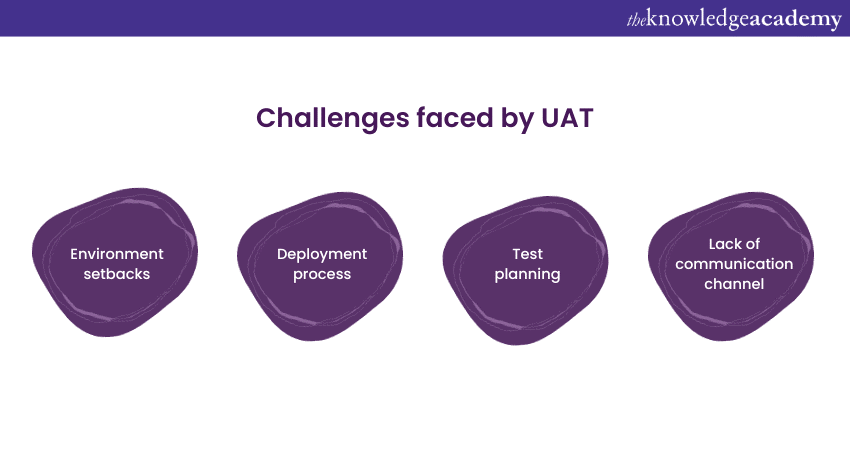We may not have the course you’re looking for. If you enquire or give us a call on +1800812339 and speak to our training experts, we may still be able to help with your training requirements.
Training Outcomes Within Your Budget!
We ensure quality, budget-alignment, and timely delivery by our expert instructors.

Nowadays, technological advancements are happening so quickly that companies must devise new products to achieve excellence and stay relevant. Introducing a new software product or service efficiently requires the implementation of many tried and tested strategies, designs and plans. This is where User Acceptance Testing in Software Testing comes into play. The primary function of User Acceptance Testing (UAT) is to achieve customer satisfaction and excellent end-User Experience.
UAT offers direct feedback from end-users, provides a narrative, encounters and rectifies mistakes in software. In this blog, we will discuss what is User Acceptance Testing in Software Testing and how its execution builds reliable software products.
Table of contents
1) What is User Acceptance Testing in Software Testing?
2) How to choose an effective User Acceptance Tester?
3) Execution of UAT
4) Challenges faced by UAT
5) Conclusion
What is User Acceptance Testing in Software Testing?
User Acceptance Testing is based on the approach that, most of the time, developers build software based on their own areas of expertise and understanding. They are perfect candidates when it comes to coding software but are not able to easily comprehend the end-user's requirements. Therefore, UAT is a step taken just before the official release to guarantee a high level of functionality and alignment with real-world-based scenarios.
User Acceptance Testing in Software Testing is done by offering the software to the target audience, mostly volunteers, to record and check for defects. This allows the volunteer end-user to use the software, figure out all the ways it can become more efficient, and establish the importance of different features in the software. It is also important to note that UAT should be carried out only after all the other software Tests like Unit, Integration, and System Testing are done.
UAT is not carried out like other Tests that require many experts. It is carried out in a different environment. This difference in the environment is the closest thing to replicating real-world scenarios. To bring diversity of the real world, an organisation includes people from each group within the target market and even stakeholders.
Want to learn the essence of Software Testing that enhances your pursuits? Check out our Software Testing courses today.
How to choose an effective User Acceptance Tester?
It is very important for organisations to select an effective User Acceptance Tester. If an organisation decides to go with the wrong professional to Test their app, they won't be able to figure out the most important aspects of the software’s usage. Here are a few pointers that will help you find a good Tester:

a) Eye for detail: A good User Acceptance Tester has an eye for detail and is someone who understands the product and service deeply.
b) Someone who has never used the application before: If you choose a Tester who is already influenced by the earlier versions of the application, they might have a partial conclusion. Choosing someone who has never used the software allows you to study how most of the audience will react once they start using it.
c) Critical thinker: If a critical thinker or analytical thinker goes through your product, they will most likely have deeper insights into the flaws and positives. They can also easily identify the subtle differences and process various data types.
Execution of UAT
Execution of UAT requires effective planning with efficient process. Let us understand how one can design a plan and process for an excellent UAT:
UAT Process
UAT process focuses on the software's usability, functionality and compatibility with the real world. This process aims to check and verify if the product meets the necessary requirements and stands true to the expectation. Mostly, stakeholders are a part of the UAT process. If any issues, defects arise, or necessary improvements are required, they are quickly corrected before the official release of the product. This process determines if the Project Manager should deploy the product for an enhanced User Experience. Here is a list of the User Acceptance Testing process phases:

a) Analysis and Test planning: This step aims to determine the UAT's objective, including the success criteria. It involves key stakeholders and business executives. Once the UAT team outlines the Testing procedure, scope, and resources, they move on to the next step.
b) Test case design: This step aims to create real-world scenarios that users will encounter. Test case designs include both functional aspects of the software as well as non-functional aspects of the software.
c) Setting up Test environment: This step aims to replicate the Test environment as closely to the production environment as possible. An effective UAT environment requires essential items like hardware, software and data to replicate production.
d) Executing a Test: In this step, the end-user operates the software according to the Test plan. Users then affirm if the software is working according to their anticipation, meets industry necessities, and aligns with the user's needs.
e) Defect reporting management: This step is established for an end-user to report all the errors and defects they faced while using the beta version of the software. Once the errors are found, the development team works on fixing these issues accordingly. Once the defective areas of the software are fixed, the end-user uses it again to check if the problems are fixed.
f) Regression Testing: This step's objective is to check if the changes brought to improve the software got new issues. This Retesting assures the UAT team that the functions that were working perfectly before the change still work the same.
g) Criteria for exit: Once User Acceptance Testing eliminates all the issues brought up by the end-users, they take the end results to the stakeholders for acceptance. If the stakeholders are satisfied by the results, they offer criteria for exit and the product is released.
UAT planning steps
UAT planning involves necessary steps like stakeholder engagement, case design and data preparation that allow UAT to filter out all the issues from the software. Let's us understand these steps.
a) Engagement of stakeholder: It is essential for everyone in the UAT to understand their roles and responsibilities. Different sectors like business analysis, project management, and end-users have to align in order to succeed in the UAT process.
b) Defining the objective: The objective of User Acceptance Testing should be clearly defined in order to grasp the flaws in software. Defining the objective also means creating different scenarios where the software will be used.
c) Designing the Test case: The Test case should cover positive and negative aspects of the software while it is being Tested. The design should be focused on replicating real-world situations as much as possible.
d) Presenting Test data: The data should be presented in such a manner that the team members can understand the issues that need to be worked on.
e) Schedule a timeline: Declaring a proper timeline for the entire process of UAT ensures that all the Tests will be done on time and the team experiences fewer delays.
Build a strong knowledge on ISTQB software by our globally recognised ISTQB Software Testing Foundation course.
Challenges faced by UAT
Although User Acceptance Testing is an efficient method to test if end-users or clients find some difficulty using the software, it still faces challenges. Let us have a look at some of these challenges:

a) Environment setbacks: Creating an environment separate from Performance Testing is critical. Otherwise, the team might end up overlooking real-world use cases. Also, you need to be careful about the fact that you might have incomplete data for User Acceptance Testing. This can lead to the neglection of critical issues that must be corrected.
b) Deployment process: It is essential that you refrain from releasing new versions of the software while Testing the older versions. This is the reason why an organisation needs to control the release of the software that is going through UAT. A way to prevent this is by Testing only the latest versions.
c) Planning a Test: Improper Testing plans can overlap UAT with other Tests. Less time and close deadlines may cause a lot of disruption, resulting in the deployment of software towards User Acceptance Testing without even completing Functional Testing.
d) Lack of communication channel: Most of the time, lack of communication between the UAT team, stakeholders and other Testing groups causes errors in Software Development. Lack of communication can also occur between the User Acceptance Testing team and the end-user who is Testing the software, resulting in fewer issues getting fixed.
Conclusion
Software Development is a critical process that requires various procedures to achieve proficiency and satisfy a user. User Acceptance Testing in Software Testing allows an organisation to understand the basics and gain in-depth insights that a developer might not understand. Using UAT after understanding the challenges like overlapping of two Tests and improper Test planning can result in the creation of an efficient system with minimum errors.
Become familiar with in-depth knowledge of optimising Testing assets with our ISTQB Advanced Test Automation Engineer course.
Frequently Asked Questions
Upcoming Business Analysis Resources Batches & Dates
Date
 Software Testing Automation Course
Software Testing Automation Course
Thu 9th Jan 2025
Thu 13th Mar 2025
Thu 12th Jun 2025
Thu 7th Aug 2025
Thu 11th Sep 2025
Thu 27th Nov 2025
Thu 18th Dec 2025







 Top Rated Course
Top Rated Course


 If you wish to make any changes to your course, please
If you wish to make any changes to your course, please


